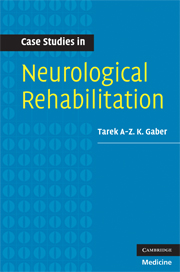Book contents
- Frontmatter
- Contents
- Preface
- Part I Clinical rehabilitation
- Part II Case studies
- 3 Medical issues in brain injury rehabilitation
- 4 Progressive neurological disorders
- 5 Medical complications of immobility
- 6 Orthotics in neurological rehabilitation
- 7 Ethical and medicolegal controversies
- 8 Chronic pain
- 9 Medically unexplained disorders
- 10 Spasticity management
- 11 Ventilatory support in rehabilitation
- 12 Sphincteric dysfunction
- 13 Communication disabilities
- 14 Sensory disability
- 15 Prescriptions for independence
- Part III Exercises in neurological rehabilitation
- Index
14 - Sensory disability
from Part II - Case studies
Published online by Cambridge University Press: 13 August 2009
- Frontmatter
- Contents
- Preface
- Part I Clinical rehabilitation
- Part II Case studies
- 3 Medical issues in brain injury rehabilitation
- 4 Progressive neurological disorders
- 5 Medical complications of immobility
- 6 Orthotics in neurological rehabilitation
- 7 Ethical and medicolegal controversies
- 8 Chronic pain
- 9 Medically unexplained disorders
- 10 Spasticity management
- 11 Ventilatory support in rehabilitation
- 12 Sphincteric dysfunction
- 13 Communication disabilities
- 14 Sensory disability
- 15 Prescriptions for independence
- Part III Exercises in neurological rehabilitation
- Index
Summary
Visually impaired patients are usually supported by specialised rehabilitation teams (e.g. sensory disability teams in the UK) and new technology has enabled patients to have a better quality of life. Equipment such as hand-held satellite navigation devices can allow patients to mobilise with much more ease in the community. Special software can convert written Internet pages to spoken words. Even the colour of shirts and ties can be detected using another useful device.
Visual impairment in neurologically impaired patients has a much more devastating effect. The visual impairment can be mild but in conjunction with the other physical, cognitive or behavioural disabilities, it can lead to a more challenging handicap. The visual impairment often has an unusual cause and this leads to a unique sensory problem. A severely ataxic patient can suffer from oscillopsia, which not only affects vision but also affects balance. Another patient with cortical blindness may be able to read small print but is unable to recognise his wife's face. These unusual problems are extremely difficult to address and a standard sensory disability team will often lack experience with such rare presentations.
Rehabilitation of such patients is best implemented jointly, with the patient's neurological rehabilitation team working with the sensory disability team. The neurological rehabilitation team will possess the necessary skills in assessment and management of the cognitive and physical problems while the sensory team can advise about issues such as home adaptations, access to services and special equipment.
- Type
- Chapter
- Information
- Case Studies in Neurological Rehabilitation , pp. 139 - 145Publisher: Cambridge University PressPrint publication year: 2008



